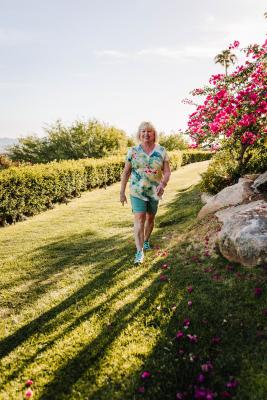Susan is ready for a new adventure after the Vertiflex™ procedure

May 13, 2022
Twelve years ago, Arizonan Susan McDowell, 73, began to experience back pain that interfered with her ability to hike, golf, ski or even walk. Diagnosed with a spinal condition named lumbar spinal stenosis (LSS), Susan’s pain worsened when standing or walking, forcing her to sit every 45 minutes until the waves of pain lessened.
LSS affects as many as half of those over the age of 60,[1] with people experiencing concentrated pain in the lower vertebrae of the spine that can also radiate into one or both thighs and legs. Those with LSS may have weakness or numbness in the legs. Caused by a narrowing of the spinal canal, compressing the nerves traveling through the lower back into the legs,2 LSS is one of the most common causes of disability among older adults, resulting in increasing supportive care costs such as physical therapy, home exercise programs, steroidal injections and oral analgesics.[2] Unfortunately, these approaches may not produce a lasting result.[3]
“Having worked as an emergency medical technician, I didn’t want a major back surgery with months of recovery and extensive physical rehabilitation,” said Susan. “After seeing my pain doctor, I was a candidate for the Vertiflex Procedure with Superion™ Indirect Decompression System (IDS) without fusion or direct decompression, which is a minimally invasive solution designed to provide long-term leg and back relief associated with moderate LSS. This procedure had me up and about in no time! Four days after the procedure, I walked four miles – some of it uphill – with no pain! That wasn’t possible before.”
Safe pain management without opioids
“IDS therapy, such as the Vertiflex Procedure, is a safe and non-opioid pain management solution that can deliver immediate pain relief and long-term positive patient outcomes,” said Tristian Pico, M.D., of the AZ Pain Doctors. “This FDA-approved solution is backed by many peer-reviewed publications, consistently demonstrating improvement of pain, function and quality of life for these patients, as well as cost-effectiveness.”
In the five-year long-term follow-up of over 80 subjects who participated in the randomized controlled trial of the Vertiflex Procedure, 90% of patients reported satisfaction with the treatment and 84% of subjects continued to demonstrate clinical success.[4] Notably, there was an 85% decrease in the proportion of the patients who were using opioids five years after implant.[5]
Pico added, “Many professional pain societies within the United States and the Multisociety Pain Working Group recognize that IDS without fusion or decompression falls within the community standards of care for patients living with LSS and the importance of access to this technology.”
"I've had no pain at all"
Susan and her doctor worked tirelessly to get insurance approval for the Vertiflex Procedure, patiently navigating through the insurance process by appealing denials and ultimately going through an Administrative Law Judge to secure approval for the procedure through her insurer. “The process took nine months but it was worth the wait as I had confidence that the treatment would save me from a time-intensive journey of trying ineffective alternative therapy options and the costs associated with it,” said Susan.
“While results may vary among patients, I’m sleeping better and am back to taking long hikes on a daily basis,” added Susan. “On a scale of one to 10, I used to rate my daily pain at a level of eight or nine, but now I’ve have had no pain at all, beyond when my small incision was healing. Now I wake up every day, refreshed and ready for a new adventure.”
To learn more about the Vertiflex Procedure, click here.
*Susan’s physician that treated her with the Vertiflex™ Procedure is Efrain I. Cubillo, M.D. of the Pain Institute of Southern Arizona.
[1] Young, J.J., Hartvigsen, J., Jensen, R.K. et al. Prevalence of multimorbid degenerative lumbar spinal stenosis with knee and/or hip osteoarthritis: protocol for a systematic review and meta-analysis. Syst Rev 9, 232 (2020). https://doi.org/10.1186/s13643-020-01478-4 Last accesesd on 4/18/2022 at https://systematicreviewsjournal.biomedcentral.com/articles/10.1186/s13643-020-01478-4#:~:text=LSS%20is%20considered%20one%20of,experience%20symptomatic%20LSS%20%5B11%5D
[2] Benyamin RM, Staats PS, MiDAS Encore I. MILD® Is an Effective Treatment for Lumbar Spinal Stenosis with Neurogenic Claudication: MiDAS ENCORE Randomized Controlled Trial. Pain Physician. 2016 May;19(4):229-42. PMID: 27228511. https://pubmed.ncbi.nlm.nih.gov/27228511/#:~:text=The%20treatment%20of%20LSS%20generally,%C2%AE%20as%20the%20next%20step.
[3] Akbari Aghdam H, Andalib A, Asadiyan Ardakani H, Telloo M, Sheikhbahaei E. A short-term oral corticosteroid for refractory lumbar spinal stenosis: a double-blinded randomized placebo-controlled clinical trial. Int J Rehabil Res. 2020 Dec;43(4):342-346. doi: 10.1097/MRR.0000000000000432. PMID: 32897933. https://pubmed.ncbi.nlm.nih.gov/32897933/
[4] Nunley PD, Patel VV, Orndorff DG, Lavelle WF, Block JE, Geisler FH. Five-year durability of stand-alone interspinous process decompression for lumbar spinal stenosis. Clin Interv Aging. 2017 Sep 6;12:1409-1417. doi: 10.2147/CIA.S143503. PMID: 28919727; PMCID: PMC5593396. Last accessed on 4/18/2022 https://pubmed.ncbi.nlm.nih.gov/28919727/
[5] Nunley PD, Deer TR, Benyamin RM, Staats PS, Block JE. Interspinous process decompression is associated with a reduction in opioid analgesia in patients with lumbar spinal stenosis. Pain Res. 2018;11:2943-2948. Last accessed on 4/18/2022 https://www.dovepress.com/interspinous-process-decompression-is-associated-with-a-reduction-in-o-peer-reviewed-fulltext-article-JPR